Discover the insider tips for crafting an effective social media strategy that increases followers and drives higher traffic, leads, and profits for your business.
Social media is where everyone is either visible or wants to be seen. With more than 4 billion users, no other platform can provide better exposure, given that you make the right moves. The only catch is that with great opportunities comes greater competition.
So, it is a legitimate concern for businesses to scale rapidly and gain mass visibility among the right audience to actually use social media to their advantage.
The first and most important action you need to take is to develop a smart social media marketing checklist that is aligned with your business goals. These are the touchstones you can start from to see what works for you and adjust your plans accordingly.
Let’s try to understand what these social media strategies entail.
A social media strategy is a well-documented plan of action containing all the necessary information regarding your social media marketing activities. It is basically a map that directs your social media marketing team’s every move. This includes your business goals, target audience, platforms you will concentrate on, content verticals, and much more.
Having an agile social media marketing strategy in place is crucial for taking quick and definitive actions. Creating strategies directs your focus on opportunities and challenges, helping you plan ahead for all possible situations.
In this blog, we are going to take you through the process of creating a social media marketing strategy step by step for businesses to bridge the gap and mend the loopholes.
And if you want a snapshot of what a strategy for social media should include, download your strategy template and customize it as you go!
1. Define Your Business Goals
Not all your goals can be fulfilled simultaneously. You have to start from scratch and write down your social media goals in order of priority. Going at them one at a time will make your efforts more effective.
Even a single end goal might seem too daunting and unreachable. So, break these goals down into smaller, achievable targets, which make them seem realistic. By setting SMART goals, i.e., making your goals specific, measurable, attainable, realistic, and time-bound, you give your team clear direction to plan and proceed. Aimlessly chasing social media success without any end goals in sight would only result in wasting your time and resources.

After segmenting your goals, you have to pinpoint KPIs or metrics that would enable you to track your progress and complete your target.
You will have to go through this process for each high-level goal you set your eyes on. So, we will outline all the main goals that businesses seek to achieve using a social media marketing strategy and how you can track them to completion.
A . Increase Brand Awareness
Translated into social media terms, increasing brand awareness means boosting your reach and impressions, among other things. According to a G2 article, 77% of shoppers prefer to buy products from brands they follow on social media. Hence, brand awareness is the first step to establishing familiarity and brewing loyalty among the audience.

Brand awareness is fairly easy to measure and track using these metrics:
- Social media reach
- Post impressions
- Follower growth
- Brand mentions
B . Boost Engagement
Social media is the place where common people can reach out and connect to all brands of all sizes. Improving active engagement on social media leads to meaningful conversations and the building of an online community. Achieving relevant engagement indicates people are taking an active interest in your brand.
You can use these markers to identify increased engagement on your social profiles:
-
Likes, comments, and shares
-
Engagement rates
-
Mentions and tags
To effectively manage and nurture this engagement, adopting a comprehensive social media management strategy is essential. It helps you stay organized, respond promptly, and maintain consistent interaction with your audience.
C . Generate High-Quality Leads
If done right, social media marketing can bring you potential leads who can be nurtured and converted into customers. These leads can be from the faction of your followers or not; either way, you can direct them right into your marketing funnel.
Here are the metrics that indicate that you are getting leads from your social profiles:
- Conversion rate
- Form submissions
- Email sign-ups
- Clicks on CTA buttons
- Traffic to landing pages
- Subscriptions for newsletters
D . Effectively Managing Customer Communication
Given the ease and openness of communication on social media customer service, individuals tend to engage with brands highly. Proactive responses showcase dedication to customer satisfaction, making enhanced customer care a primary goal through social media.
Here are the metrics that need to be monitored to gauge the effectiveness of communication management through social media:
- Response time
- Customer review rating
- Sentiment analysis
E. Drive Traffic to Your Website
The ultimate goal of all businesses is to generate ROI from their marketing, and leading social traffic to their websites is how they can achieve that.
Here are metrics to measure if your goal is to increase traffic to your web pages:
- Website sessions
- Referral traffic
- Click-through rate
- Bounce rate
- Session duration
- Webpage heat maps
You can chase these goals one at a time or go for multiple, according to your business needs and the current status of your social media profiles.
Once you’ve decided on your primary objective, there are multiple factors to consider. You can take the help of a business mentor for expert guidance on this.
So, let’s move on to the next step in your social media strategy.
2. Understand Your Target Audience
As marketers, you know that all your social media marketing strategies must be focused on your target audience. So, make it a priority to sketch out a clear image of your target audience and target market to give direction to your social media marketing strategy.
Lots of marketers out there forget to define their target group before they begin marketing. Not surprisingly, their attempts prove to be unfruitful as they do not know the people they are marketing to!
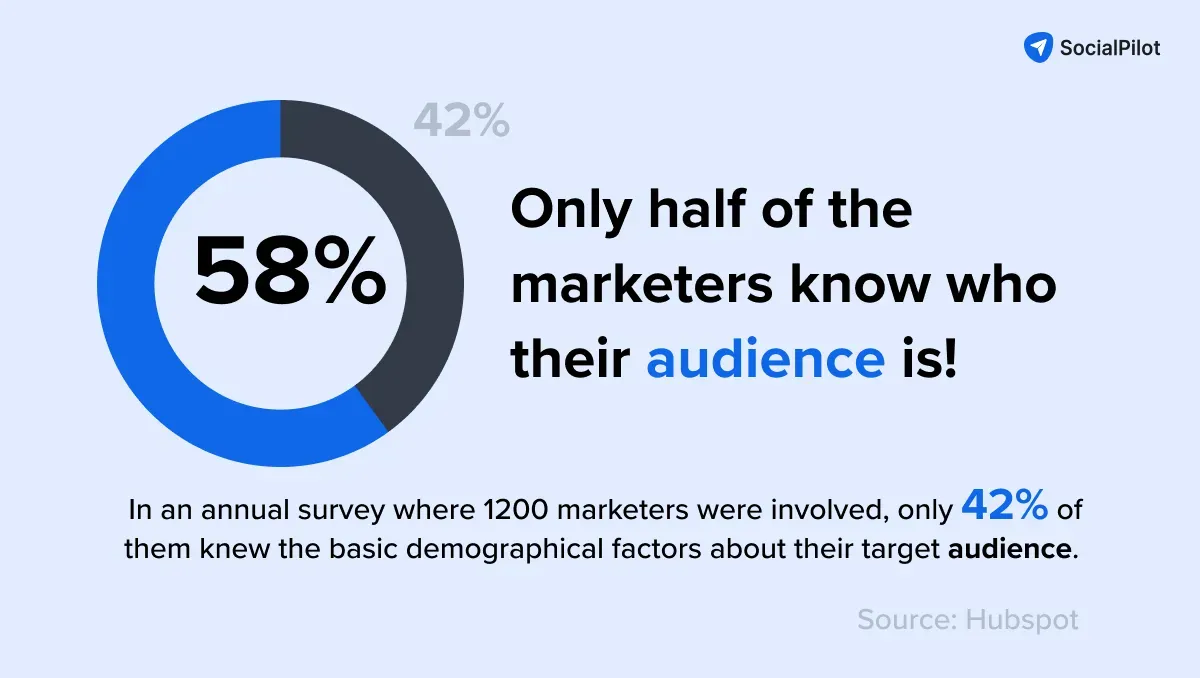
If you’re wondering why you need to conduct target audience research for social media marketing? We’ve got the answer.
Conduct Market Research
To create an ideal buyer persona, first identify their basic demographics, then pinpoint their habits and motivations. Social media provides cues such as ongoing trends and pain points, which you can use to make the right connections.
Start with your competitors, their collaborators and followers, brands from related niches, and their followers, then combine all the information to create a nuanced user persona.
Create Customer Personas
Social media marketing is all about personalized messaging.If you want to create content that resonates with your audience, you need to know them. This is possible if you create customer personas by analyzing your current audience.
You can define your targeted audience and their persona based on their age, demographics, interest, behavior, and language. Look at the platforms that they are using consistently, how often they are using these, and the kinds of content they are engaging with.
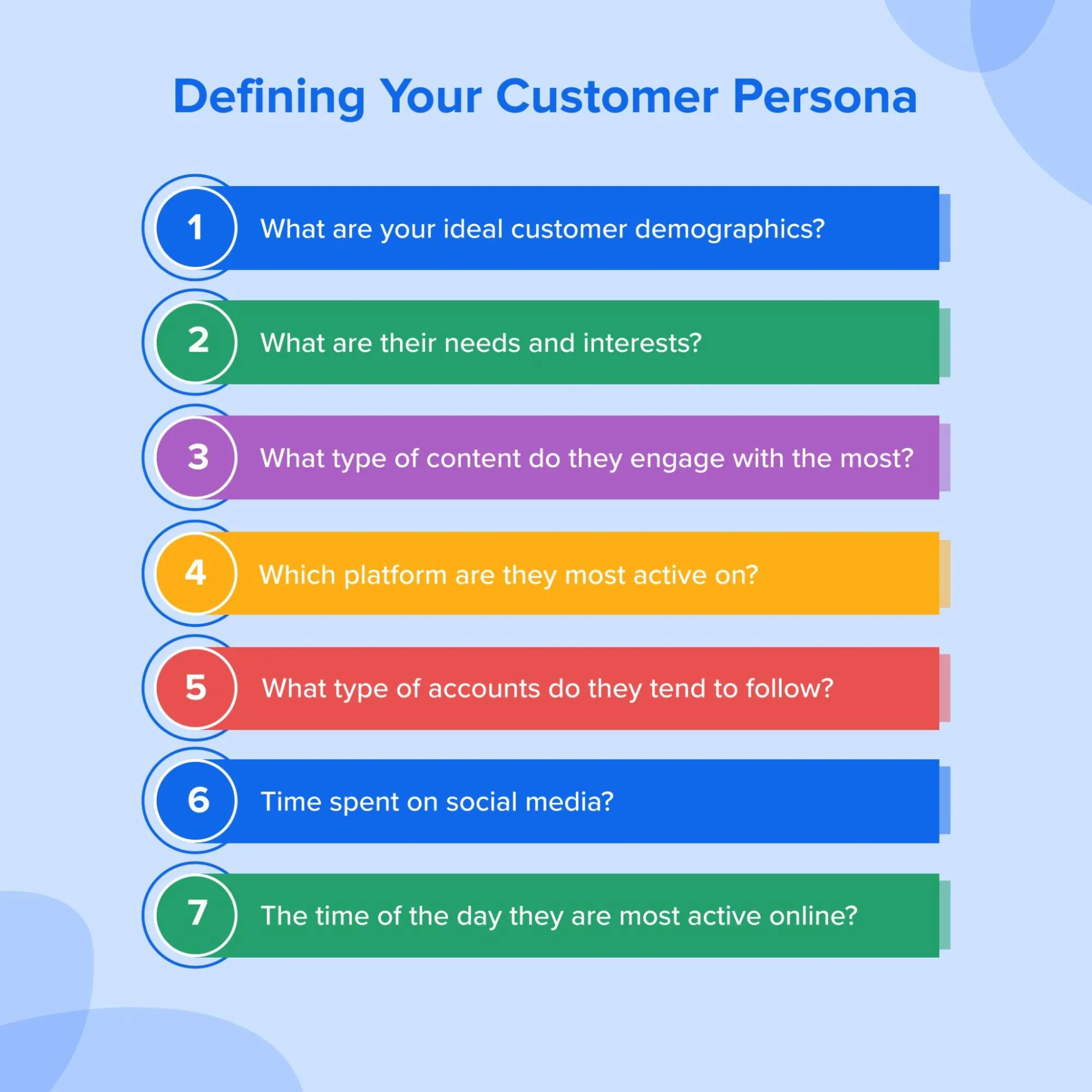
Try to answer all these questions using the results of your study. Having all these insights on your audience at hand will help you align your every move with customers’ preferences and pain points.
The success of your social media marketing initiatives also depends on which social media platforms you choose for marketing. But what businesses do is create accounts on every social media platform that comes their way.
Large brands like Starbucks and Target might be able to sustain this approach, but smaller businesses have to function on limited resources. If you are the latter type, it’s vital that you set your sights on the right social media platforms to succeed in your marketing efforts.
Wondering how to make this crucial choice?
The solution here is to pay attention to your business category and the type of products or services you offer. You also need to consider whether your business follows a B2C, C2C, or B2B model.
Here are some facts about the major social media platforms for businesses for you to decide which one of them fits you the best.
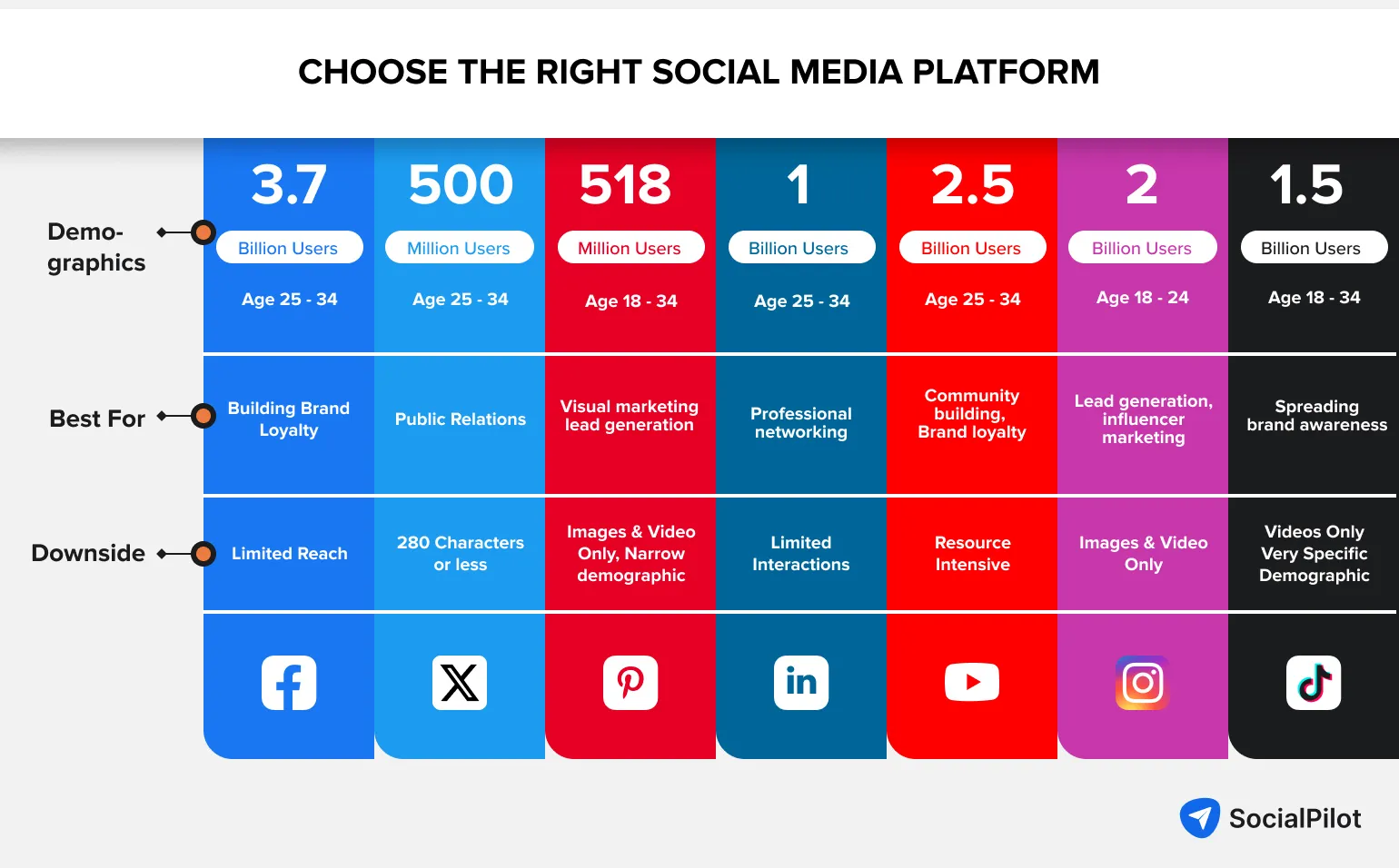
Facebook: The majority of users are aged between 25-34, with 43.7% females and 56.3% males. Facebook stands out as an exceptional advertising platform due to its advanced targeting options and diverse ad formats. To fully leverage its potential, developing a well-rounded Facebook marketing strategy is key for businesses aiming to reach and engage this active demographic effectively.
Instagram: Favoured by Gen-Z with an almost equal age distribution. Instagram offers easier organic growth for businesses than Facebook, thanks to its Discover page, hashtags, and location tools. It’s also a prime platform for influencer marketing, making a strong Instagram marketing strategy essential for brands aiming to engage this dynamic audience.
TikTok: This famous video-sharing platform also boasts a user base of 18- to 24-year-olds of age with a 50-50 male-to-female ratio. TikTok is considered the best for spreading brand awareness by showing off product tutorials and use cases. It’s the place you can easily go viral on.
YouTube: The largest user segment, aged 25-34, has a gender split favoring males at 54.4% and females at 45.6%. Renowned for its highly engaged comment section, it’s perfect for fostering a community. Plus, it’s an optimal platform for marketing both long and short-form videos. To make the most of this, having a clear YouTube marketing strategy can help brands create compelling content, optimize video SEO, and effectively engage their audience across different formats.
X (formerly Twitter): 38% of users fall between 18 to 34 years old, with 66% being males and females 34%. Twitter ads provide a direct route to your audience, surpassing the wait for organic reach. Promoted Tweets are a swift way to expand your reach, enabling people to discover your profile.
Pinterest: With 30% of users aged 25 to 34 and a remarkable 76.2% being female, Pinterest is a must for any company with a visual marketing strategy. It’s an ideal platform for delivering captivating content to highly motivated online shoppers. The average time spent on Pinterest (per session) is a whopping 14.2 minutes.
LinkedIn: With over a billion users, LinkedIn attracts 25 to 34-year-olds the most, with 43.7% female and 57.3% male users. Crucial for personal brand marketing and network expansion, it’s indispensable for B2B companies. It also proves effective for luxury goods, services, and technical firms such as software providers. Developing a strong LinkedIn marketing strategy can help businesses leverage this professional network to generate leads, build authority, and foster meaningful connections.
However, every business has unique constraints, so you must consider your available resources, such as time, budget, and team capacity, in choosing the right platform. Prioritize the platforms that best align with your social media marketing goals, target audience, and available resources.
4. Analyze Your Competitors
This might be the most insightful and informative step you perform while creating your social media marketing strategy. There is no scarcity of businesses with a prominent social media presence. Hence, it’s most likely that you will find competitors in your industry whom you can conduct an in-depth analysis on to figure out what kind of strategies they employ and what works among their audience.
Identify the Competition
Finding competitive brands is easy enough on social media and otherwise. You just have to search with the right terms: keywords for search engines and hashtags for social channels.
Consider all types of brands with the same target audience as yours. This includes direct competitors who are marketing the same products as you. Indirect competitors, on the other hand, are from related niches and have the same target audience but sell different products.
Below is an example of the direct and indirect competitors: two cola drinks of the same type and two condiments, but of different types.
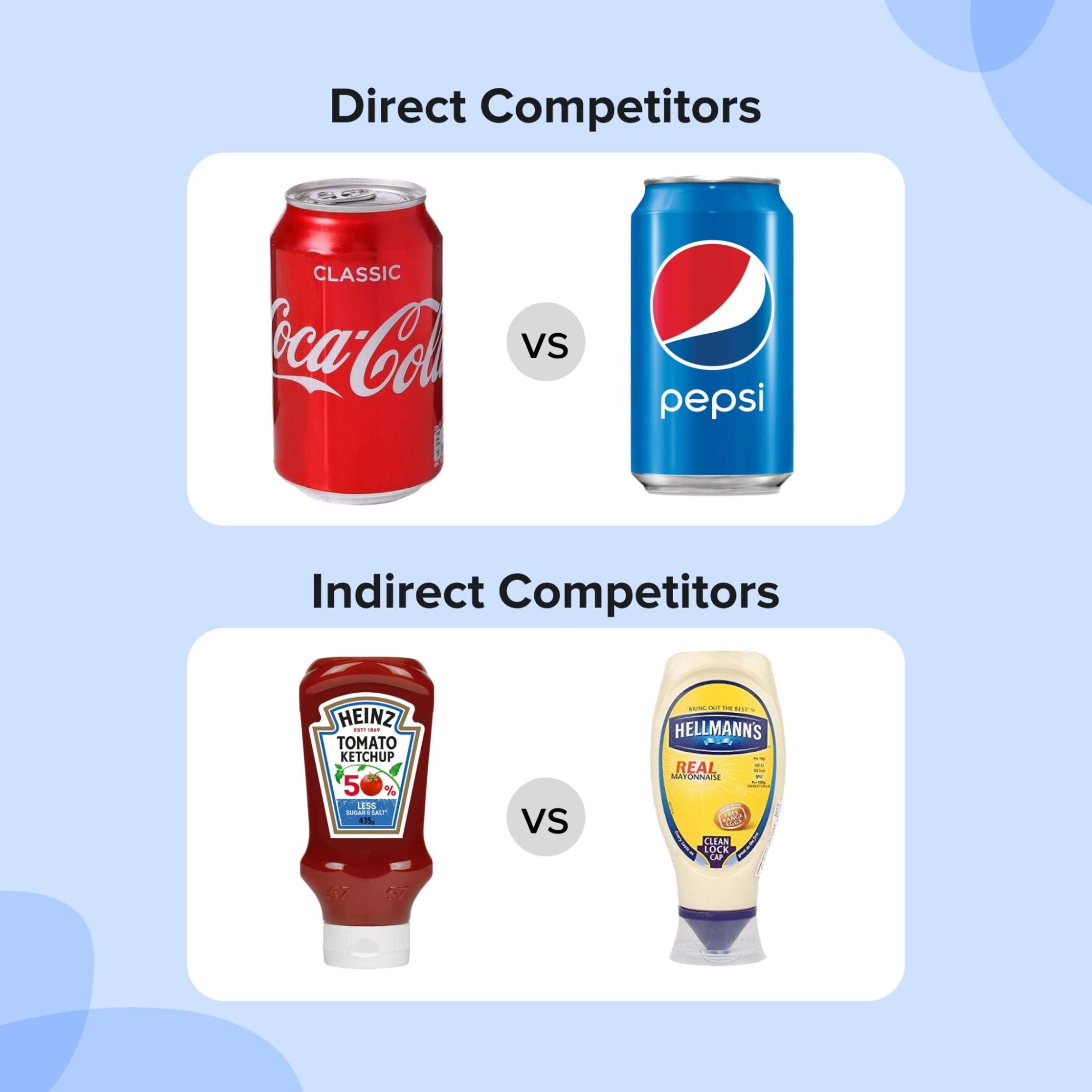
Perform A Complete Competitive Analysis
Once you have ID’d the right brands, now it’s time to look at their social media marketing strategy from every angle. Establishing prominent benchmarks is very crucial in the initial planning phase gives you an idea of how to craft your own plan.

To sneak around your competitors’ profiles, you need to know what you are looking for.
Understand their online presence by the communication style and content focus. Analyze their marketing tactics, audience engagement, and lead generation methods very keenly to gain a competitive edge. Pay attention to their posting frequency, targeting strategies, hashtag usage, and collaborations to inform your own strategy.
In a nutshell, keep track of your competitors’ activity on social media and incorporate some of their best points in your strategy. If you want to learn the step-by-step guide for competitor analysis, our Competitor Analysis Guide could help you along.
After observing your peers in depth, it’s time to work on your own unique approach.
Do you know what distinguishes you the most from your competitors, particularly on social media? It is your brand voice.
Your brand voice helps establish a connection between you and your audience. It can also help your brand develop trust and credibility with your target demographics.
Look at Your Company’s Mission and Values
To cultivate a unique brand voice, start by revisiting your brand’s mission statement and then defining its core values. These pre-defined communication pillars give your brand a personality, which is then reflected in social media branding communication.
Chewy is a pet care brand whose mission is “To be the most trusted and convenient destination for pet parents (and partners) everywhere.”
Now, this mission establishes the fact that they serve the needs of the pets first and foremost. Also, using the term pet “parent” instead of pet owner helps them tap into the emotions of their customers.
This statement is not just a statement to the brand, as it is clearly visible in their social media posts. More than promoting their products, they prioritize the pets in question, showing how they believe in their mission. They also embody the spirit of their brand by showing their employees being loving pet owners themselves.
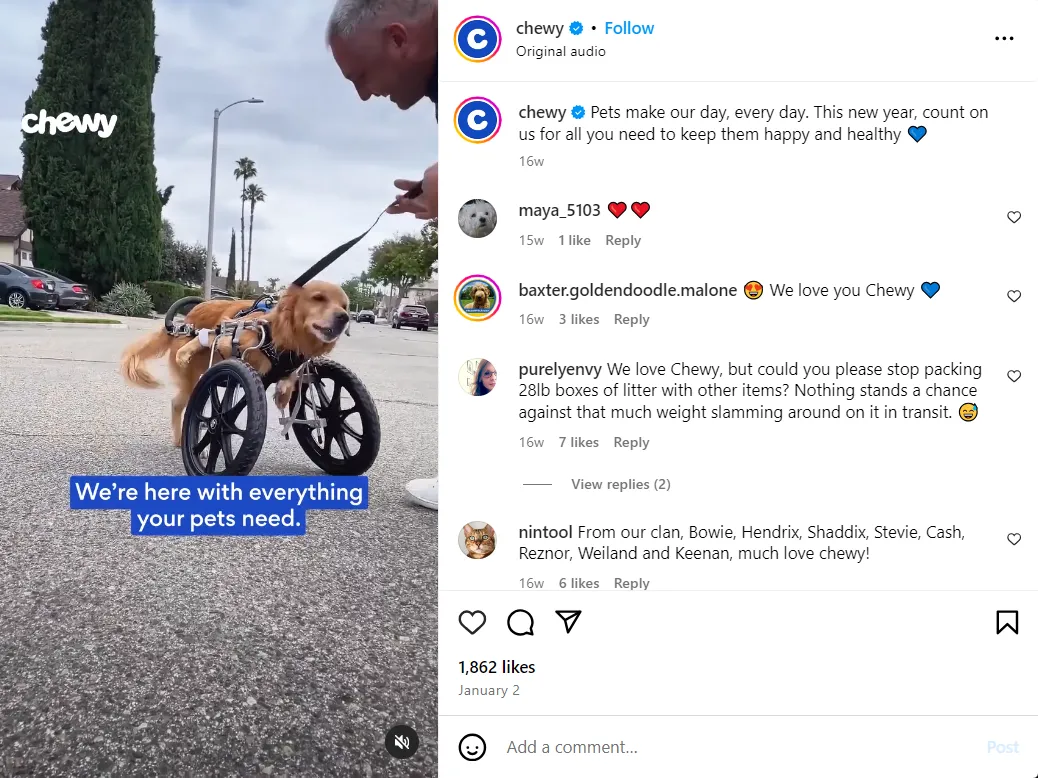
Get Inspired by Your Audience
The next step is to understand your audience and the kind of tone they would respond to the best.
So, the key to grabbing eyeballs is to focus on what your audience wants to listen to and create a cohesive and consistent brand voice that stands out.
During competitive analysis, you might have encountered the type of content your contemporaries are succeeding with. This will let you know what your audience likes the best.
This research should involve monitoring audience posts, going through comment sections, and analyzing user-generated content. Knowing their tone and language will help immensely when you are in the process of crafting a personalized voice for yourself.
Outline The Don’ts
If you now have a nascent idea of what your social media voice sounds like, it’s time to set some boundaries. While in the process of creating your digital marketing strategy, you might have figured out what characteristics of your brand should be. But it’s as important to know what you do not want to sound like.
So, during brainstorming, note down some boundaries to make your brand voice more concise. They can be statements like:
- Don’t sound overtly friendly
- Don’t sound too pretentious
- Don’t be sales-y
Once you do this activity, it will become easy to consolidate your brand voice.
Define Your Brand Voice in Short
Now, all that’s left to do is define your voice for your social media. This is the simplest step in the process. After establishing the persona to go with, you have to use essentially 3 to 5 words to define your main characteristics.
Netflix is a winning example of a brand with a unique voice that is witty, funny, and entertaining to keep customers hooked to its social channels.

In the above post, you can get a hint of the friendly and informal tone of Netflix, which keeps the conversation flowing among the users it targets.
Authenticity helps to build trust, so don’t try to be someone you’re not. Test and refine your brand voice over time to ensure it resonates with your audience and effectively promotes your brand identity.
The next crucial step for social media marketing is to optimize your social media profiles. This process is about integrating the necessary information into your profile, including who you are, what you do, and your area of expertise.
The basic idea behind optimizing your profile is to ensure that you showcase your capabilities and make a good impression on visitors to convert them into your followers.
If you don’t optimize all your social media profiles, they may appear disjointed and uninteresting to profile visitors.
The result? Losing new customers, subscribers, and lower visibility on social media. So, don’t take that chance; perform complete profile optimization.
You can start by selecting a high-quality profile picture and cover photo that reflects your brand identity. Write a compelling and concise bio highlighting your unique value proposition, including all relevant information about your business, and use relevant keywords for the search.
“Your social media profile is often the first touchpoint for potential customers. Make sure it’s not only visually appealing but also clearly communicates what your brand stands for. A well-crafted bio with the right keywords can significantly boost your discoverability, shares Katelyn Rhoades, CEO of Enfluence Marketing Agency.
Here is a perfect example from Burt’s Bees’ Twitter profile, which is optimized to attract new visitors and more followers. They have showcased a high-quality profile, cover image, and a concise bio with relevant keywords to rank for search queries.
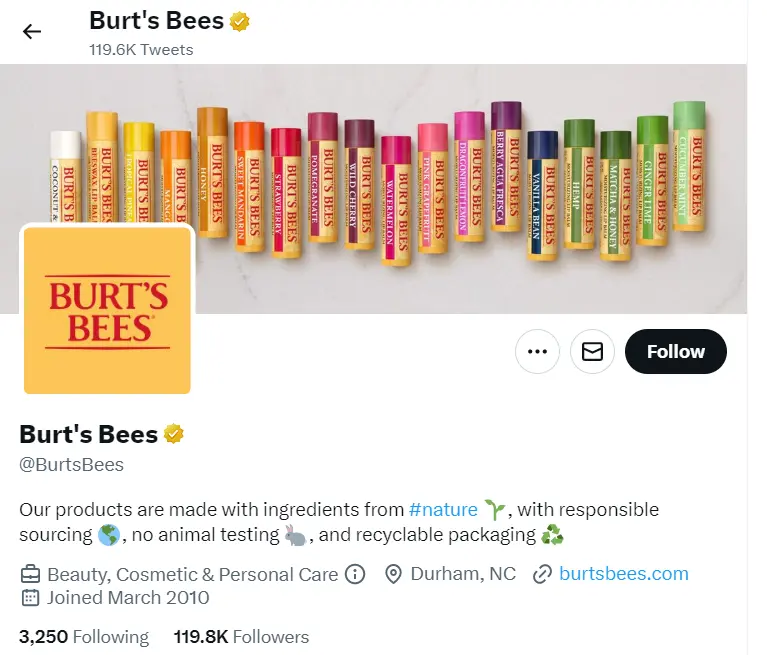
To further optimize your profiles, cross-promote your social media accounts by linking them to each other. Doing this will also increase your visibility with your target audience.
7. Develop a Compelling Content Plan
Now that you have outlined the most important criteria for your social media marketing strategy, it is time to create a winning content plan. It must be a well-etched plan with relevant, interesting, and timely content.
You have to dive deep into the details for creating a content strategy, as this will guide all your specific moves on social media, such as how to craft your content, what type of posts to publish on which profile, the publishing frequencies, and time slots.
So, without much ado, let’s get into specifics.
Brainstorm or Curate Post Ideas
At this point in your journey, you must be well-versed in the kinds of content you need to have in your portfolio. So begin your content plan by putting together a board full of post ideas. Do not differentiate between image posts, Reels, Stories, or videos during brainstorming sessions. To streamline your planning, SocialPilot Content Calendar comes with Notes that allow users to jot down ideas, record ideas for different types of content, and keep track of campaign strategies.
Consider different genres of posts while making your content strategy. There are many options for you to choose from:
- Educational Posts: You can share tips, how-tos, tutorials, and industry insights that add value to your audience’s lives or work.
- Entertainment-Centric Posts: Creating memes, jokes, quizzes, and stories engages your audience in a light-hearted way.
- Inspirational Posts: Quotes, success stories, case studies, and motivational posts can inspire people.
- Interactive Posts: Polls, questions, and contests encourage the audience to interact and help brands generate leads.
- Promotional Posts: Although these should be used sparingly, promotional posts about your products, services, or events are necessary to drive conversions.
We recommend that you start with a particular type of content. This will give your brand a solid identity and recognition. Once you have garnered some significant engagement and followers, diversify your content and pepper your plan with multiple types of posts.
Businesses tend to go overboard with promotional and shoppable content as they tend to glean leads and sales from them. But this mars their authenticity in the eyes of their followers. So, the wise move would be to follow the golden ratio – 80: 20.
This rule states that, ideally, out of the entirety of your content, 20% should be promotional, and the rest of the 80% should be generic. This establishes the perfect balance for a brand image, having the majority of your content be about a variety of topics and peppering promotional posts in between to achieve your business objectives.
Manage Resources Efficiently
Attractive images, infographics, and compelling videos are crucial for better social media engagement. Producing such content requires the involvement of graphic designers, content marketers, creative people, and video editing experts.
Make sure you start creating a repository of graphic assets before you start publishing content so that you have content at hand for quick postings.
As it involves different resources, managing them wisely is very important. You can store all your content assets in cloud storage or a content library, from which you can easily access and retrieve them during post creation. However, using social media marketing tools to manage your campaigns can significantly simplify resource management, thanks to their built-in content libraries that serve as centralized repositories.
Build Content Calendar
If you’ve got your content ideas and verticals down pat, it’s time to set up your content calendar. This entails deciding on a posting schedule for a week or a whole month, and assigning content to every posting slot.
Laying everything out on a calendar will help you remain organized, provide transparency to your team, and deliver consistent and goal-oriented social media content.
Now, every day in the calendar must be plotted with factors listed for effective content creation aligned to the strategy.
- Platform
- Account name
- Time of publishing
- Type of post
- Name of the assignee
- Campaign or goal (if any)
- Post copies and creative assets
- URLs and hashtags to add to the post
These details have to be decided and filled out chronologically. The platforms, account names, and publishing time dictate the posting frequency. Make sure to analyze the best time to post on social media for your profiles and include all the platforms in the posting slot you have decided to target in the earlier steps of forming your social media marketing strategy.
After that, focus on the post type, whether it’s a meme, poll, image post, or Reel. This is followed by the names of the content creators on your team who are responsible for delivering that particular post.
Once the monthly social media calendar is planned, it’s time for execution!
The content will now be created and added to the respective posting slots. This must include the post caption, the creative assets (images, videos, GIFs, etc.), the URLs, and hashtags to be included.
You can keep and manage your content calendar in many different ways. It could be done manually in an Excel sheet, or you could download our social media calendar template. It is well structured to accommodate all your needs, but can be edited to customize to your unique needs.
SocialPilot’s Automated Social Media Calendar
These are all good choices but we have a more high-tech option for you. SocialPilot, a social media management tool, has a multipurpose content calendar feature.

This dynamic dashboard enables users to create, customize, and schedule social media posts across multiple accounts. Posts can be easily arranged on a content calendar with drag-and-drop functionality. Users can filter views to see monthly, weekly, or daily posting plans.
And the best part? The tool will automatically publish your posts at the date and time you assign the post on the calendar.
Once your content is going live consistently, it’s time to track how well it’s resonating with your audience. Monitoring key social media metrics like reach, engagement, clicks, and conversions is essential to evaluating the effectiveness of your strategy.
That’s where SocialPilot Analytics steps in.
Beyond just showing basic numbers, SocialPilot now offers in-depth analytics for multiple platforms (like Facebook, Instagram, LinkedIn, X, and more) in one unified dashboard. It helps you identify what’s working, what’s not, and where to optimize.
You can:
-
Monitor platform-specific and cross-platform performance from one place.
-
Dive deep into audience behavior and engagement trends.
-
Generate and schedule custom-branded reports to send automatically to clients or stakeholders.
-
Analyze metrics based on post types, hashtags, and content formats.
-
Use advanced filters and comparison views to get sharper insights.
And yes, it even helps you understand audience sentiment, giving you real clues on how your brand is perceived and how to align your messaging.
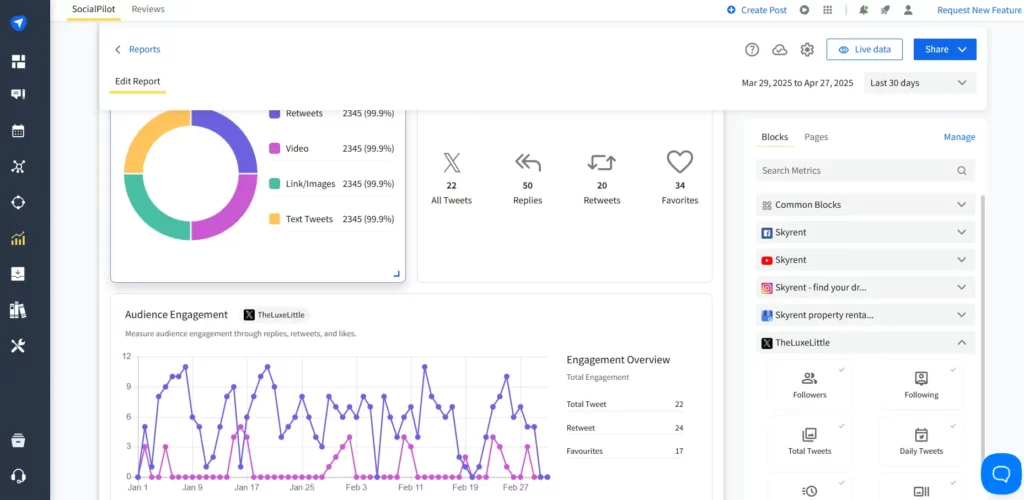
If you’re managing multiple client accounts or pages, SocialPilot makes it effortless to track, compare, and report – all in just a few clicks.
9. Build a Strong Community Around Your Brand
Building a community helps you engage with your audience. It helps you to create a sense of belonging and establish trust among your customers.
To build your community, begin by engaging with your followers, responding to comments and messages, and participating in conversations related to your industry or niche.
To build and maintain a community, one can get on Q&A sessions with customers through Stories, host exciting giveaways, feature user-generated content, and acknowledge loyal followers.
The brand Away, for instance, does its best by featuring user-generated content and showcasing how brands can be responsive to win a community.

In this post, Away doesn’t restrict itself to promoting UGC content but also reflects responsive behavior by engaging with commenters on the post. Being responsive is the key to building a loyal community, as it signals that you are an accessible brand and your audience can count on you.
Another effective way to build a community is to cross-promote your content on all your social channels. For example, you can share your Facebook page link on Twitter or share your Twitter profile link in your Instagram bio.
Doing so will help you attract and retain an audience from different platforms and convert them into loyal followers.
However, conducting and engaging in such outreach initiatives can take a lot of leg work.
The best way to organize, streamline, and manage all social interactions is to use social listening tools and ensure seamless communication across your social media profiles.
10. Additional Step: Leverage Paid Advertising for A Boost
Ad spending on social media marketing is projected to reach $219 billion in 2024. Wondering why marketers invest this much in ads on social?
It’s because Paid advertising helps you reach a larger audience and target specific demographics relevant to your business. It also allows brands and businesses to attract new followers and find potential customers.
Here is how you can leverage paid advertising for social media marketing:
- Set a budget: Determine how much you want to spend on your paid social media advertising campaign. You can either set a daily budget or a total campaign budget.
- Create an eye-catching ad: Make sure to create a visually appealing ad that can grab the attention of your target audience. You also need to include a clear call-to-action (CTA), such as a link to your website or to make a purchase.
- Monitor and adjust your campaign: Keep an eye on how your ad is performing and make adjustments as needed. You can track metrics such as clicks, conversions, and engagement to see what is working. Use this data to optimize your ad and improve its performance.
Conclusion
Whether you are just starting or looking to optimize your existing social media marketing strategies, a well-thought-out strategy can help you stay on track and achieve success. It is essential for any business wanting to leverage social media to grow its brand, engage with customers, and drive sales.
However, taking care of all the factors crucial for social media marketing can be tricky and time-consuming. You can use SocialPilot, a social media tool that can take over a major chunk of your repetitive tasks. It can help you create a content calendar, publish content, schedule first comments, and monitor performance for all social channels without investing hours in social media management.
So, try SocialPilot for free and take your social media marketing to the next level.




